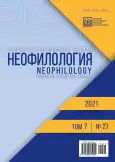German-Slavic toponymic contacts in East Germany
- Авторлар: Belyaev A.N.1
-
Мекемелер:
- Bashkir State Agrarian University
- Шығарылым: Том 7, № 27 (2021)
- Беттер: 434-443
- Бөлім: ONOMASTICS
- URL: https://journal-vniispk.ru/2587-6953/article/view/302426
- DOI: https://doi.org/10.20310/2587-6953-2021-7-27-434-443
- ID: 302426
Дәйексөз келтіру
Толық мәтін
Аннотация
We consider the issues of the relationship between the German language and the Sorbian language. The material of the study is the toponyms that are common in the territory that extends in the east to the course of the rivers Bober, Quays and Oder, in the north – to the vicinity of Berlin, and in the west goes beyond the Saale River. The relevance of the study is due to the desire for a more in-depth study of German-Slavic language contacts issues. The novelty of the work lies in the consideration of the issue in various aspects: language levels, sociolinguistic, areal. We study the mechanisms and properties of adaptation of Slavic toponyms at all linguistic levels, clarify the methodology for describing the integration process of borrowed toponyms, describe the phase’s characteristic of the integration process. We show that among the Slavs and Germans, semantic parallelism in the acts of nomination is often noted, due to the geographical environment. We establish that the linguo-geographic relations that developed during the German-Lusatian toponymic interaction are heterogeneous in nature. We conclude that interlanguage contacts in the field of toponymy were complex and did not have a monolithic character, as was previously believed. As a prospect for further research, it is planned to study the Slavic Germanic place names in the Slavic languages.
Негізгі сөздер
Авторлар туралы
A. Belyaev
Bashkir State Agrarian University
Хат алмасуға жауапты Автор.
Email: anbelajew@mail.ru
ORCID iD: 0000-0003-1784-4704
Doctor of Philology, Associate Professor
34 50-let Oktyabrya St., Ufa 450001, Russian FederationӘдебиет тізімі
- Kryukov P.A. Motivirovka nominatsii oykonimov istoriko-geograficheskogo regiona Verkhnyaya Luzhitsa (Ge-rmaniya) [The motivation of oikonyms nomination in historical and geographical region upper Lusatia (Germa-ny)]. Obshchestvennyye nauki – Social Science, 2016, no. 2-1, pp. 429-438. (In Russian).
- Kryukov P.A. Motivirovka pereimenovaniy oykonimov istoriko-geograficheskogo regiona Verkhnyaya Luzhitsa (Germaniya) [The motivation of oikonyms renamings in historical and geographical region upper Lusatia (Germany)]. Obshchestvennyye nauki – Social Science, 2018, no. 1, pp. 101-114. (In Russian).
- Hutter J. Slawische Spuren im heutigen Rheinland-Pfalz, Saarland und Baden-Württemberg. Aachen, Patrimo-nium-Verlag Publ., 2017, 252 p. (In German).
- Marterior K. Die slavischen Siedlungen im östlichen Holstein: eine zweispra-chige Sprachlandschaft? Hamburg, Verlag Dr. Kovač Publ., 2018, 299 p. (In German).
- Marterior K., Nübler N. (eds.). Mehrsprachige Sprachlandschaften: das Problem der slavisch-deutschen Misch-toponyme. Akten der Kieler Tagung 16/-18/ Oktober 2014. Leipzig, Leipziger Universitätsverlag GmbH Publ., 2016, 262 p. (In German).
- Wenzel W. Die slawische Frühgeschichte Sachsens im Lichte der Namen. Hamburg, Baar Publ., 2017, 204 p. (In German).
- Zschieschang C. … ac iuxta unam paludem. Wasser, Siedlung und Grenzen in der deutsch-slavischen Kontakt-zone. Ein Beispiel aus der östlichen Niderlausitz. Namenkundliche Informationen, Leipzig, Leipziger Universi-tätsverlag Publ., 2019, no. 111, pp. 344-362. (In German).
- Khengst K. Issledovaniya po slavyanskoy onomastike v Germanii [Studies in Slavic onomastics in Germany: an overview]. Voprosy onomastiki – Problems of Onomastics, 2019, vol. 16, no. 2, pp. 269-280. (In Russian).
- Bichlmeier H. Die wichtigsten Suffixe in slawischen Familiennamen und ihre Eindeutschungsergebnisse – ein Überblick. Namenkundliche Informationen, Leipzig, Leipziger Universitätsverlag Publ., 2019, no. 111, pp. 123-152. (In German).
- Hengst K. Sprachkontakte, Sprachstudien und Entlehnungen im östlichen Mitteldeutschland seit einem Jahrtausend. Wien, Praesens Verlag Publ., 2015, 870 p. (In German).
- Matveyev A.K. Onomatologiya [Onomatology]. Moscow, Nauka Publ., 2006, 292 p. (In Russian).
- Hengst K. Forschungsergebnisse zu Integrationsprozessen von Sied-lungsnamen aus der Minderheitensprache Sorbisch im sorbisch-deutschen Sprach-kontaktraum. Namenkundliche Informationen, Leipzig, Leipziger Uni-versitätsverlag Publ., 2013, no. 101/102, pp. 219-249. (In German).
- Ambrosiani P. Parallel’nyye nazvaniya v pribaltiysko-finskoy i russkoy oykonimii Ingermanlandii [Parallel na-mes in the Baltic-Finnish and Russian oikonymy of Ingermanlandia]. Voprosy onomastiki – Problems of Ono-mastics, 2008, no. 6, pp. 83-92. (In Russian).
- Berger D. Geographische Namen in Deutschland: Herkunft und Bedeu-tung der Namen von Ländern, Städten, Bergen und Gewässern. Mannheim, Leipzig, Wien, Zürich, Dudenverlag Publ., 1993, 296 p. (In German).
- Koß G. Namenforschung : eine Einführung in die Onomastik. 3., aktualisierte Aufl. Tübingen, Niemeyer Publ., 2002, 248 p. (In German).
- Superanskaya A.V. Obshchaya teoriya imeni sobstvennogo [General Theory of Proper Name]. Moscow, LIB-ROKOM Publishing House, 2012, 368 p. (In Russian).
Қосымша файлдар










